If you are looking for information on a list of all systems in the human body, then you are at the right place.
The human body operates as a single entity but is made up of several systems that work independently. The human body is composed of different types of cells that subsequently form an organ system consisting of many organs and tissues. All the organ systems work together to maintain homeostasis.
Each system is associated with a specific function for the well-being of an individual where the integrated working of these body systems ensures survival. Let’s discuss the list of all systems in the human body.
List of All Systems in The Human Body
The human body is made up of 12 basic organ systems that work interdependently to perform all the essential body functions.
The 12 organ systems include
- The Nervous system
- The Circulatory system
- The Respiratory system
- The Digestive system
- The Excretory system
- The Reproductive system
- The Endocrine system
- The Skeletal system
- The Muscular system
- The Renal system
- The Lymphatic system
- The Integumentary system
01. The Nervous System
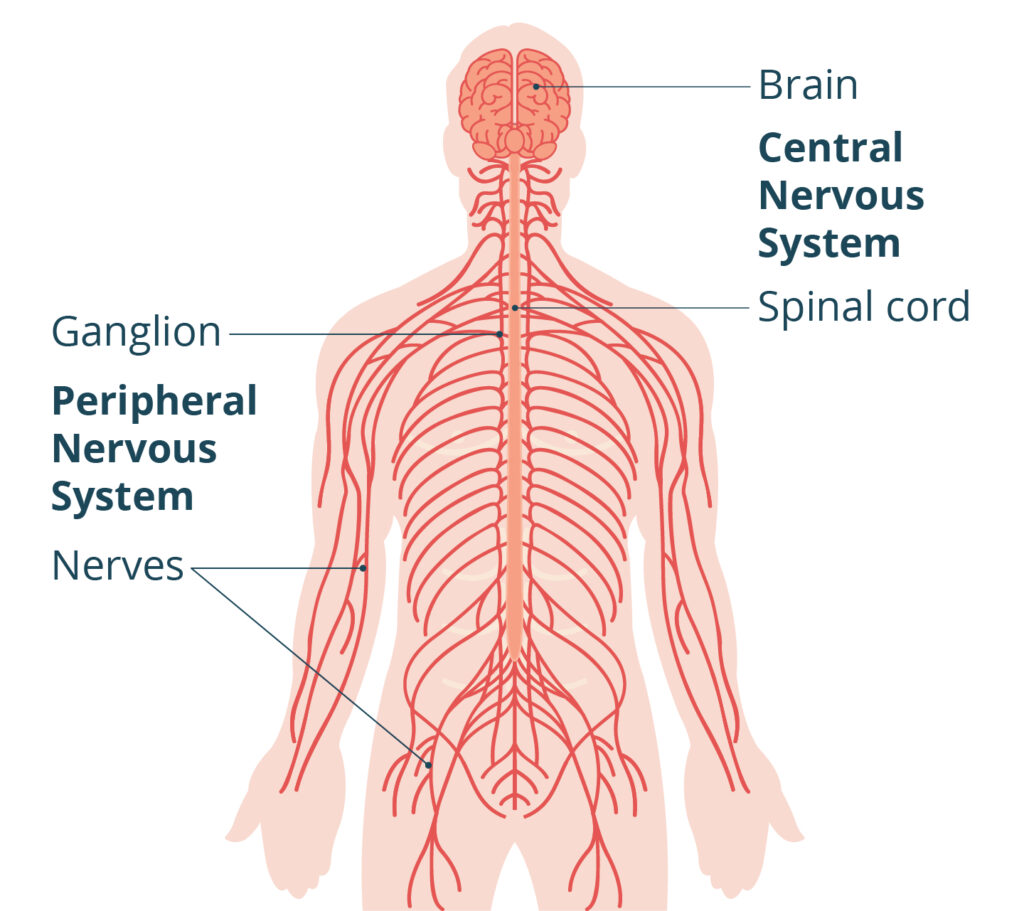
Nervous System | Source: Health Direct Australia
The nervous system in the human body is a highly complex part of the body that coordinates sensory and motor information by receiving and transmitting signals to and from different parts of the body. The nervous system detects and responds to environmental changes that affect the body.
Parts of the Nervous System
Mainly divided into two.
The Central Nervous System (CNS)
The central nervous system is made up of the brain and spinal cord, and controls how we think, learn, move, and feel.
- The brain: The brain acts as a computer that controls the body’s functions and it is protected by the skull.
- The spinal cord: The spinal cord sends messages between the brain and the body’s nerves. The spinal cord is protected by vertebrae, a set of ring-shaped bones.
- The CNS has seven basic parts:
- The medulla
- The pons
- The cerebellum
- The midbrain
- The diencephalon
- The cerebral hemispheres
- The spinal cord
Peripheral Nervous System (PNS)
A network of nerves that branch out from the spinal cord and extend to all parts of the body, carrying messages to and from the CNS.
- Sensory division – Consists of sensory nerves
- Motor division – Consists of motor nerves
- Enteric nervous system
- Somatic nervous system (voluntary)
- Autonomic nervous system(involuntary)
- Sympathetic division
- Parasympathetic division.
02. The Circulatory System
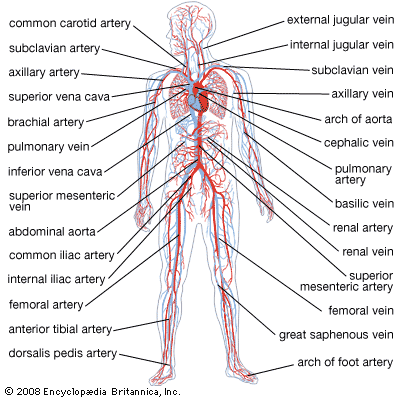
Parts of circulatory system | Source: Britannica
The circulatory system comprises the heart, a muscular organ between the lungs, an extensive network of blood vessels, and blood. The circulatory system supplies oxygen and nutrients to the body cells to keep them working and it also removes waste products from the body.
Major Circuits in Circulatory System
- Pulmonary circulation is a loop from the right ventricle pumping deoxygenated blood into the lungs through the pulmonary artery where it is oxygenated and returns the oxygenated blood to the left atrium through pulmonary veins.
- The systemic circulation is a loop that pumps oxygenated blood from the left ventricle to various parts of the body through the aorta and returns the deoxygenated blood to the right atrium through large veins known as venae cavae.
- Coronary circulation provides blood supply to the heart muscles via the right and left coronary arteries and returns blood into the coronary sinus via coronary veins.
- The cerebral circulation supplies blood to the brain via internal carotid arteries and vertebral arteries.
03. The Respiratory System
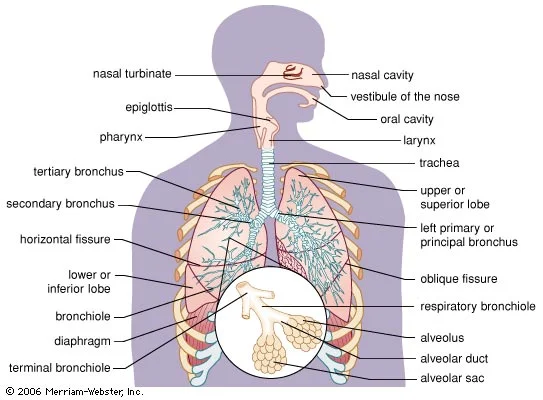
Components of the human respiratory system | Source: Britannica
The respiratory system consists of the nose, nasal cavity, pharynx, larynx, trachea, a pair of lungs, bronchi, bronchioles, and alveoli altogether provide the route by which atmospheric oxygen enters the body and the route for removal of carbon dioxide.
Different parts of the body are involved in respiration and each of them has its function,
- Mouth, nose, sinuses, pharynx, trachea, bronchial tubes: Delivery of air to the lungs.
- Diaphragm and Ribs: Muscles and bones that help move the air in and out
- Alveoli, bronchioles, bronchi, lung lobes, pleura: Components that work along with lungs and blood vessels.
04. The Digestive System
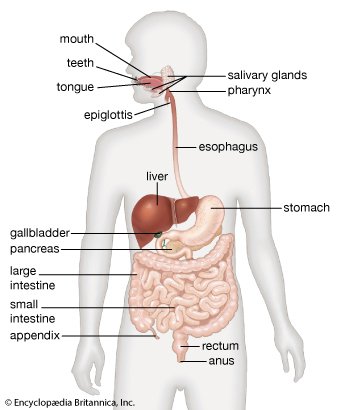
Parts of the Human digestive system | Source: Britannica
The digestive system consists of the gastrointestinal tract along with its accessory organs such as the tongue, salivary glands, pancreas, liver, and gallbladder. It involves digestive processes that gradually break down the food that we intake into smaller component forms for absorption.
The activities of the digestive system include ingestion, propulsion, digestion, absorption, and elimination.
Organs of the Digestive System
- Alimentary canal
- Mouth
- Pharynx
- Oesophagus
- Stomach
- Small intestine
- Large intestine
- Rectum and anus
- Accessory organs
- Three pairs of salivary glands
- The pancreas
- The liver and the biliary duct
05. The Excretory System
The excretory system removes excess, unnecessary waste products from the body via bile, urine, feces, sweat, or breath to maintain internal chemical homeostasis and prevent damage to the body due to the build-up of toxins. It performs a dual function in eliminating the waste products of metabolism and draining the body of broken-down components in either liquid or gaseous state.
Systems Involved in Excretion
- The urinary system with a pair of kidneys, a pair of ureters, a urethra, and a urinary bladder eliminates wastes from the bloodstream through the production of urine.
- Respiratory system eliminates gaseous waste products from the body.
- Biliary system – The liver detoxifies chemicals, poisons, and toxins, and also produces bile, which breaks down fats into unusable wastes.
- Integumentary system – Sweat glands in the skin excrete waste in the form of sweat.
06. The Reproductive System
The reproductive system, also known as the genital system, consists of anatomical organs involved in sexual reproduction. It includes the external genitalia and several internal organs involved in internal fertilization.
The human reproductive system is divided into,
Female Reproductive System
- External genitalia – Labia majora, labia minora, clitoris, vestibular glands, perineum, the vaginal orifice.
- Internal genitalia – Vagina, uterus, uterine tubes, ovaries.
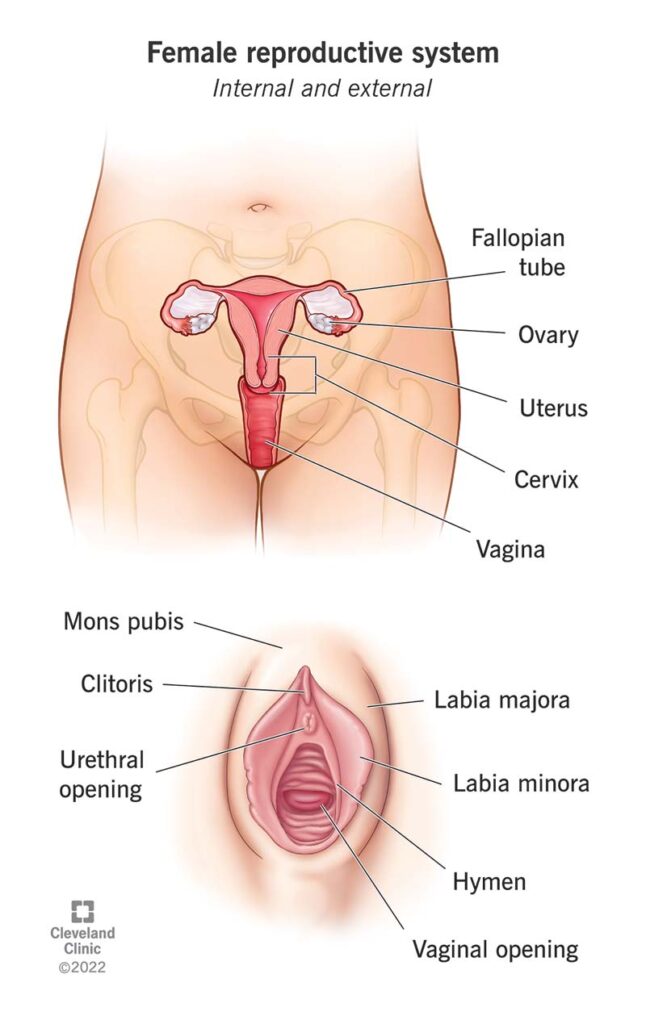
Female reproductive system | Source: Cleveland clinic
Male Reproductive System
- Scrotum
- Testes
- Seminal vesicles
- Ejaculatory ducts
- Prostate gland
- Urethra and penis

Male reproductive system | Source: Cleveland clinic
07. The Endocrine System
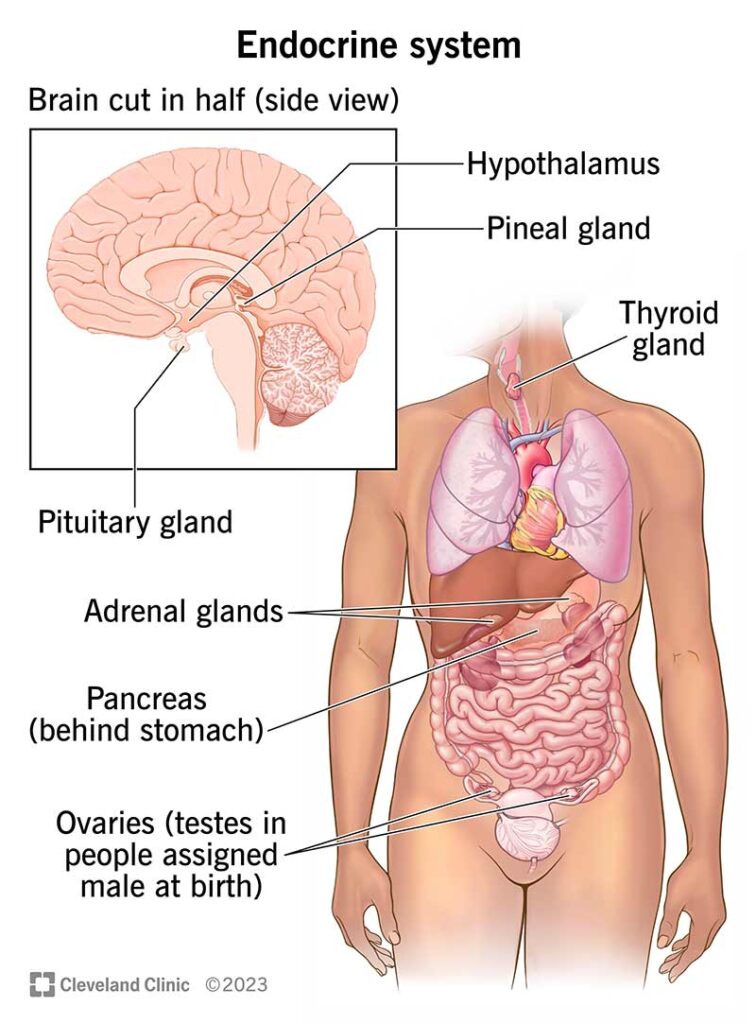
The endocrine system | Source: Cleveland clinic
The endocrine system acts as a messenger system consisting of hormones(chemical messengers) released by the internal glands directly into the circulation.
Organs and tissues use hormones to communicate and regulate various physiological and behavioral activities.
The hypothalamus is the neural control system for all endocrine systems. The major endocrine glands include,
- The posterior pituitary gland secretes antidiuretic hormone and oxytocin.
- A thyroid gland that produces and synthesizes thyroid hormones T3 and T4.
- Parathyroid glands secrete parathyroid hormone.
- Adrenal glands produce adrenaline, aldosterone, and cortisol.
- The pancreas contains islets of Langerhans, which consist of alpha cells secreting glucagon, and beta cells secreting insulin.
08. The skeletal system
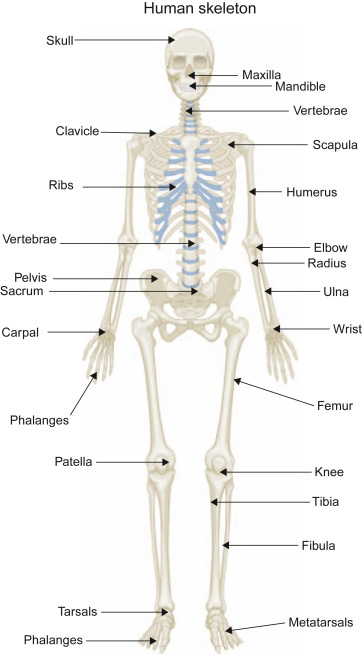
The Skeletal System| Source: Gerald Litwack, Organ System and Tissue
The bones, tendons, and ligaments make up the skeletal system, which supports the human body. It contributes about 20 percent of a human’s body weight. It is composed of around 206 bones.
The major functions of the skeletal system include facilitation of movement, producing blood cells from the bone marrow, protecting and supporting organs, and storing minerals like calcium and vitamin D.
The skeletal system consists of mainly four connective tissues
- Bones: A hard mass of connective tissue made up of specialized bone cells(osteocytes) and calcium.
- Ligament: It is a fibrous connective tissue that attaches bone to bone.
- Tendon: A tendon is a fibrous connective tissue that attaches muscle to bone.
- Joints: It is an articular point that connects two bones in a human skeletal system.
Types of the Skeletal System
The adult human skeleton consists of 206 bones. The bones can be grouped into two types,
- Axial skeleton: It consists of a skull, rib cage, and vertebral column.
- Appendicular skeleton: The appendicular skeleton is composed of bones of the pectoral girdle, upper limbs, pelvic girdle, and lower limbs.
- The pectoral girdle consists of the clavicle (collar bone) and scapula(shoulder bone). The pelvic girdle is formed by the fusion of three bones, the ilium, ischium, and pubis.
09. The Muscular System

The muscular system | Source: Britannica
The muscular system consists of skeletal, smooth, and cardiac muscle that permits movement of the body, maintains posture, and helps circulate blood throughout the body. The somatic nervous system controls voluntary movements of skeletal muscles and the autonomic nervous system controls the involuntary movements of cardiac and smooth muscles.
The muscular system together with the skeletal system forms the musculoskeletal system that is responsible for the movement of the body.
Three Distinct Types of Muscles
- Skeletal muscle is a type of striated muscle that is composed of muscle fibers which in turn are composed of myofibrils.
- The cardiac muscle is a striated muscle and its movement is involuntary.
- A smooth muscle is an involuntary non-striated muscle.
10. The Renal System
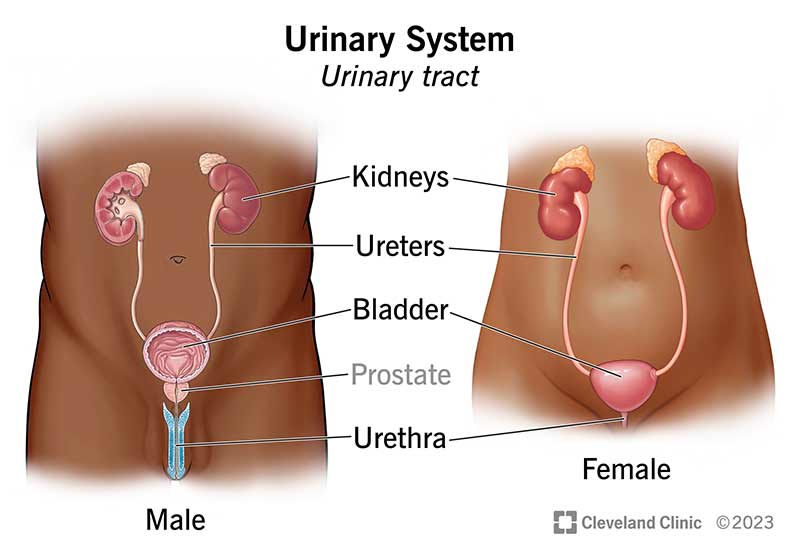
The Renal system | Source: Cleveland Clinic
The renal system also known as the urinary system consists of kidneys, ureters, urinary bladder, and urethra. The renal system plays a major role in maintaining the homeostasis of water and electrolytes, eliminating wastes from the body, regulating blood volume and blood pressure, and regulating blood pH.
The kidneys produce 1-2 liters of urine, which contains metabolic wastes including the nitrogenous compounds urea and uric acid, ions, and excreted drugs. The urinary system is the main excretory system and consists of the following parts,
- A pair of kidneys that secrete urine.
- A pair of ureters that pass urine from the kidneys to the urinary bladder.
- The urinary bladder collects and stores urine.
- The urethra through where the elimination of urine takes place.
11. The Lymphatic System
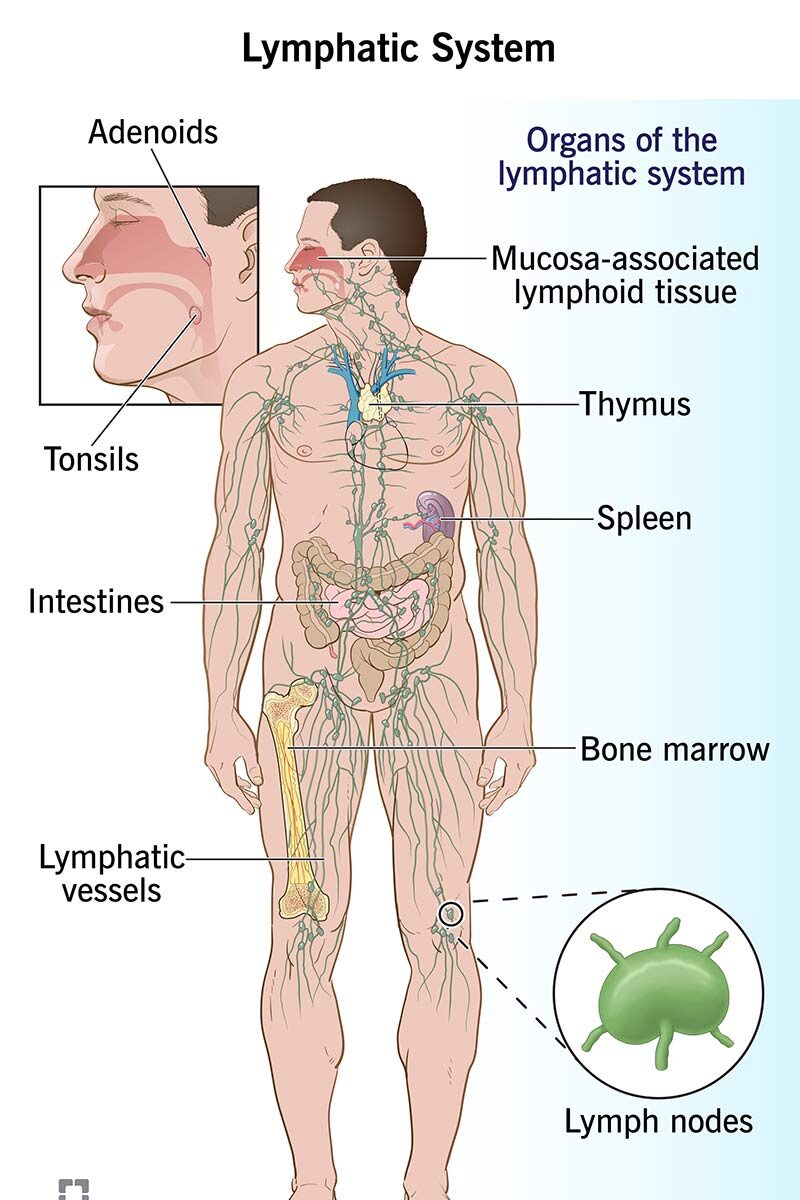
The Lymphatic System | Source: Cleveland clinic
The lymphatic system is an organ system that is a part of the immune system and is complementary to the circulatory system. The main functions are to provide tissue drainage, absorption in the small intestine, and immunity.
The lymphatic system consists of a large network of lymphatic vessels, lymph nodes, lymphatic or lymphoid organs, and lymphoid tissues. The lymphatic vessels carry a clear fluid known as lymph that contains waste products and cellular debris.
Parts of Lymphatic System
- Lymph vessels run alongside arteries and veins serving the area and become larger as they join together to form two large ducts which empty lymph into the subclavian veins.
- Lymph nodes are oval or bean-shaped organs that lie along the lymph vessels. The lymph is filtered by the reticular and lymphatic tissue as it passes through the lymph node.
- Lymph organs consist of the spleen which is the largest lymph organ, the bone marrow, and the thymus gland.
- Lymphoid tissue consists of connective tissue formed from reticular fibers along with lymphocytes through lymph passes.
- Lymph is a clear watery fluid that transports the plasma proteins that seep out of the capillary beds back to the bloodstream.
12. The Integumentary System
The integumentary system is the set of organs forming the outermost layer of the body. It comprises the skin and its appendages. This system acts as a physical barrier between the external and internal environment to protect the body.
The integumentary system serves to maintain water balance, protect deeper tissues, regulate body temperature, excrete wastes, and allow the detection of pain, pressure, and temperature as it is the site for sensory receptors.
Integumentary System Parts
- Skin is the largest organ of the body made up of three layers epidermis, dermis, and hypodermis. The main function of the skin is to protect the body from various stresses.
- Nails protect the ends of the fingers and toes.
- Hair is made of a protein called keratin. Eyelashes and eyebrows help protect the eyes from dirt and water. Hair on the head maintains heat in the body.
- Glands are found throughout the skin releasing various substances to the skin’s surface. It consists of the following glands:
- Sebaceous glands produce sebum
- Ceruminous glands in ears secrete ear wax
- Sudoriferous glands secrete sweat through the skin. Eccrine and apocrine are the two types of sweat glands.
Conclusion
In this article, we’ve covered all the necessary information on a list of all systems in the human body. I hope this article has provided you with all the information you’ve been looking for. If you find this content useful please do share it with your friends. If you have any queries, let us know in the comment box below!
FAQs
01. Which system is responsible for the movement of the human body?
The musculoskeletal system is another name for the locomotor system. It comprises the skeleton, the skeletal muscles, tendons, ligaments, joints, cartilage, and other connective tissue. These parts work together to allow movement.
02. What are the two regulatory systems in the human body?
The nervous and endocrine systems are the two regulatory systems in the human body. These systems use chemical and electrical signals that travel between cells to control bodily functions. For this communication, each system has a different pathway.
03. What is the duct system in the human body?
Channels, tubes, or pipes that transport moving air are called ducts. In HVAC (heating, ventilation, and air conditioning), ducts are conduits or passageways that deliver and remove air. These needed airflows include supply air, return air, and exhaust air. A building’s ventilation system uses a network of ducts to draw in air from outside the structure and exhaust contaminated indoor air through air-moving appliances like blowers and fans.
04. What is a body system example?
Systems of the body are groups of tissues and organs that cooperate to carry out vital functions for the body. If an organ performs more than one function, it may belong to multiple bodily systems. There is only one body system in which other organs and tissues are utilized. A few examples include the respiratory, nervous, and digestive systems.
Liked these blog keep continue your reading with Definition and Scope of Anatomy and Physiology.
